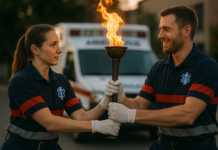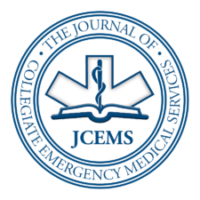| Download PDF (Available Soon) | |
| Author and Article Information |
Abstract
Background: While public assistance (PA) has been shown to increase access to EMS care for underserved rural populations, few studies document the effect of PA on the outcome of cardiovascular emergencies. Objectives: This study aims to investigate the association between cardiac emergency outcomes and PA usage in rural areas. Methods: A retrospective cross-sectional analysis of cardiac patient encounters was performed utilizing data from the 2021 NEMSIS database. Patient encounters were separated based on acuity level into minor, emergent, and critical. To determine if PA and 911 respond to significantly different acuity calls, a two-sample Z-test of proportions was conducted. A χ2 test of independence was performed to determine whether statistically significant variations in acuity exist as a result of PA and 911-response differences. Results: The two-sample Z-test of proportions indicated a statistically significant difference in the proportion of acuity levels between PA and 911-response (p<0.01). The χ2 test of independence (χ2=0.797, p=0.6713) suggested that there is no significant association between change in acuity and the presence of PA. Conclusion: The proportion of critical acuity cardiac encounters is higher amongst 911-responses, while minor acuity encounters are more common in PA-responses. The presence of PA has no significant relationship with the improvement or deterioration of acuity.
Introduction
Individuals in rural areas often have worse health outcomes compared to those in urban communities. Rural populations are characterized as older, sicker, and poorer than their urban counterparts.1 In general, residents in rural areas experience health disparities that result in higher incidence of disease, worse chronic health conditions, and lower life expectancies.2 These health outcomes can be attributed to systemic factors including higher rates of poverty, social and physical isolation, and transportation limitations.3, 4
These barriers to healthcare access have contributed to higher morbidity and mortality in rural areas. In 2019, rural locations had a 20% higher death rate than urban areas, with the largest differences in deaths resulting from heart disease, cancer, and unintentional injuries.5 Heart disease is a leading cause of death among rural residents.6 In particular, rural populations experience an increased burden of heart attack and heart failure mortality compared with urban populations.7 There is an urgent need to address the rural-urban disparities influencing the outcomes of cardiovascular emergencies.
Rural emergency medical services (EMS) provide critical care for remote and isolated communities.8 However, they are often overstretched, understaffed, and underfunded. Rural EMS is faced with unique challenges like rural geography, workforce shortages with declining volunteerism, and higher fixed costs. In particular, some rural areas are characterized by “ambulance deserts”, which are defined as populated census blocks with geographic centers outside of a 25-minute ambulance service area.8 Ambulance deserts have been shown to prevent rural EMS from providing timely care to stabilize and transport sick patients.9 The delay in EMS response can be especially problematic for cardiac emergency patients that require rapid treatment and potential transport.10 The map in Fig. 1 designed by the Rural Health Research Center presents the percentage of rural and urban county populations that reside in ambulance deserts. The proportion of rural counties that have over 15% of the population living in an ambulance desert is noticeably higher than urban locations.11

Figure 1. Percent of Rural and Urban County Populations Living in Ambulance Deserts, 2021 – 202211
Public assistance (PA) efforts have been shown to fill in the gaps in EMS and increase access to care for underserved rural populations.12 While public assistance programs encompass a broader range of social safety net interventions, this study focuses on community paramedic programs and their role in responding to cardiovascular emergencies in rural areas. Rather than providing a direct solution to a lack of EMS resources in a life-threatening emergency, community paramedicine programs serve as a critical pathway to home-health visits with a primary care approach for these rural residents. These regionally-based programs have improved health outcomes in rural communities by helping people manage their conditions, avoid the need for acute emergency care, and reduce their ED and inpatient use.13
However, few studies document the association between public assistance and the outcomes of cardiovascular prehospital emergencies. The association between cardiac emergency outcomes and public assistance usage in rural areas across the United States has not been widely studied or documented. Investigating the effectiveness of public assistance programs can better inform initiatives to expand such programs. Specifically, elucidating the role that public assistance plays in managing cardiac emergencies can support efforts to improve the health outcomes of marginalized communities.
Methods
A retrospective cross-sectional study of EMS encounters was performed utilizing a convenience sample of EMS encounters in the 2021 National Emergency Medical Services Information System (NEMSIS) Version 3.4.0 of the public release research data set.14 NEMSIS provides a framework for collecting, storing, and sharing standardized EMS data across the United States. The 2021 data set included 48,982,990 EMS activations submitted by 13,949 EMS agencies in 53 states and territories. The data set is deidentified and organized by individual EMS encounters rather than individual patients. Thus, this study was exempt from review by the institutional review board.
The data analysis was limited to the first 1 million activations in the NEMSIS database due to limited technological capabilities. From these 1 million activations, inclusion and exclusion criteria narrowed down the sample size. Firstly, only EMS reports that included a primary cardiac impression were included in the study. Primary cardiac impression was defined by a range of cardiac-related emergencies including the following conditions: angina, arrhythmia, cardiac arrest, myocardial infarction, heart failure, and hypertension.
Next, only reports that were made in rural settings were included. The sample was further narrowed down to focus only on EMS reports that involved 911-response or public-assistance-(PA)-response. The most common mechanisms for activating PA-response include: (1) direct activation through 911 call triage, where dispatchers identify cases appropriate for community paramedic response rather than traditional emergency transport; (2) referral-based activation, where healthcare providers, hospital discharge coordinators, or social workers can request community paramedic follow-up for high-risk patients; and (3) dedicated non-emergency lines that residents can call directly for assistance that falls within community paramedicine scope. This particular analysis includes encounters initiated through all three pathways.
Additionally, this study excluded EMS responses to mass casualty incidents, air or water rescues, and EMS calls with no patients. To remove potential data entry errors, the top 0.1% of longest response time, on-scene time, and transport time were excluded, as well. Upon accounting for these inclusion and exclusion criteria, a total of 9,195 EMS activations remained.
The NEMSIS data set is based on EMS activations, which means that multiple emergency resources may have responded to the same call, potentially resulting in multiple PCR submissions to the dataset. The incident identification PCRkey was used to link individual EMS activations across different tables within the database. The following NEMSIS tables were linked together by PCRkey: ComputedElements, FACTPCRMEDICATION, FACTPCRPRIMARYIMPRESSION, FACTPCRSCENEDELAY, GROUP_PCRPATIENTRACEGROUP, Pub_PCRevents.
Standard definitions were taken from the NEMSIS Data Dictionary. As defined by NEMSIS, public assistance refers to the unit that responded to provide non-traditional or EMS services (e.g., community paramedicine, mobile integrated healthcare, elderly or disabled patient assistance, public education, injury prevention). NEMSIS defines the acuity level of a particular emergency using the following descriptions:
- Critical (red): patient is critical, but has a chance of survival, and cannot survive without immediate treatment.
- Emergent (yellow): patient condition is stable but serious and they are not in immediate danger of death. These patients should be able to follow a simple command.
- Minor (green): patient is ambulatory and may need medical care at some point, after more critical injuries have been treated. Generally, these patients will have been escorted to a staging area to await delayed evaluation and transportation.
- Dead (black): individual who has no clinical signs of life and/or obviously fatal injuries.
To determine whether PA-calls and 911-calls differ significantly, the two sample Z-test of proportions was conducted. The relationship between public assistance and acuity level was further investigated using the Chi-Square Test of Independence, which determined if there were statistically significant associations between the presence of public assistance and change in acuity levels. For all analyses, a p-value of < 0.05 was used to signify statistical significance. Data wrangling and analyses were conducted on RStudio 2023 (Version 2023.09.1+494) and statistical analyses were conducted using Microsoft Excel 2023 (Version 16.79.1). Data were imported to RStudio from .txt files from DropBox.
Results
After accounting for the inclusion and exclusion criteria, a total of 9,195 EMS activations remained. Of these EMS activations, 1,011 activations were rural (40 were PA-response; 971 were 911-response). To begin, demographic information was collected to characterize the population of rural communities that utilize PA- and 911-response (Table 1). In all groups, the age range 50-75 had the highest proportion of cardiac emergencies, with White males having a higher proportion than females. Geographically, the South consistently had the highest incidence of cardiac EMS activations.
Table 1: Demographic Characteristics of Cardiac Emergency Patients Evaluated by Public Assistance and 911 in Rural Areas

Next, specific call data for PA-response and 911-response calls were analyzed (Table 2). The proportion of primary cardiac impressions varied across the four groups. In PA-response activations, hypertension presented as the highest proportion in rural areas. In 911-response activations, arrhythmia presented as the highest proportion. Medications were never given during PA-responses. In 911-responses, however, medication for managing a cardiac emergency was given 83% of the time. Lastly, initial and final acuity were also documented. In general, PA-responses were activated most commonly for minor acuity Green calls.
Table 2: Count and Percentage of Primary Cardiac Impression, Medication Usage, Medication Response, and Initial/Final Acuity

To determine whether the proportion of calls responded by public assistance and 911 differ significantly, the two sample Z-test of proportions was conducted (Table 3). At the 0.05 significance level, the results of the two-sample Z-test of proportions indicate a statistically significant difference in the proportion of activations with Red initial acuity between those with a PA-response and those with a 911-response (p = 0.0038). The proportion of Red acuity activations is higher amongst 911-responses.
This statement holds true for all Red and Yellow initial/final acuities, but not Green acuities. At the 0.05 significance level, the results indicate a statistically significant difference (p = 0.0001) and suggest that the proportion of Green acuity activations is higher amongst PA-responses. For Black acuity activations, the data was not statistically significant (p > 0.05), as indicated by the red text.
Table 3: Two sample Z-test of proportions

The relationship between public assistance and acuity level was further assessed using the Chi-Square Test of Independence (Table 4). At the 0.05 significance level, the results of the chi-square test for independence do not provide sufficient evidence to reject the null hypothesis (χ² = 0.797, p = 0.6713). This suggests that there is no significant association between the presence of PA and change in acuity.
Table 4: Two sample Z-test of proportions

Discussion
The findings of this study reveal a significant difference between activations with a PA-response and 911-response in the proportion of minor, emergent, and critical acuity patients. The proportion of emergent and critical acuity activations is higher amongst 911-responses. In general, 911-responses are equipped with more experienced personnel and a wider breadth of medical equipment to be able to handle higher acuity emergencies. On the other hand, the proportion of minor acuity activations is found to be higher in PA-responses. This suggests that community paramedics and other public assistance responders are most often being dispatched to lower acuity calls that they are more equipped to effectively manage. Public assistance calls usually involve incidents that are non-life-threatening but still require prompt medical attention. The findings of this study can inform efforts to allocate resources accordingly and optimize the distribution of personnel and vehicles to address specific low acuity cardiac health needs, especially in rural areas that are characterized by ambulance deserts.
Analyzing the change from initial to final acuity can provide insight into whether patient health outcomes improved or deteriorated throughout the course of a call. The results of this study indicate that there is no significant association between the presence of PA and change in acuity. This suggests that PA-response and 911-response do not see different changes in acuity. For the lower acuity incidents like hypertension that PA responds to, the changes in acuity are comparable to the outcomes of the higher acuity calls that traditional 911 responds to. In addition to responding to emergency medical calls, public assistance programs also play a crucial role in promoting community health, preventive care, and education. Their impact may extend beyond the immediate context of emergency response, affecting the overall well-being of residents. However, it is worthwhile to note that failing to find a significant association does not imply the absence of an association; it may be due to sample variability. Further research and a larger sample size may be needed to draw more definitive conclusions.
Limitations
This study has several limitations that should be acknowledged. Firstly, its retrospective data analysis relies on the accuracy of EMS provider documentation, which is susceptible to missing or erroneous information. Additionally, a smaller amount of data was available for PA-responses (N = 40) relative to 911-responses (N = 971). This may have impacted data robustness and the quality of data comparisons.
The NEMSIS dataset utilized in this study has inherent limitations. While NEMSIS provides a large convenience sample of EMS encounters across the United States, it is not a population-based, nationally representative sample. The dataset includes data submitted voluntarily by participating EMS agencies within states and territories. Thus, the data may contain potential selection bias. A significant limitation pertains to the classification of “public assistance” as a response type in the NEMSIS dataset. This broad category encompasses a wide range of services, including elderly assistance, injury prevention, immunization efforts, and community paramedicine. Unfortunately, the NEMSIS database does not allow precise filtration for community paramedic encounters as distinct from other public assistance responses. This lack of specificity makes it challenging to determine which cardiac incidents were directly addressed by community paramedicine programs versus other public assistance programs. Our analysis attempted to identify likely community paramedicine cases through multiple identification methods including service codes, provider classifications, and intervention types, but some misclassification may have occurred. This limitation highlights the need for more specific coding mechanisms within national EMS databases to support research on evolving care models like community paramedicine. Future iterations of the NEMSIS database would benefit from incorporating variables that clearly distinguish community paramedicine responses from other types of public assistance, enabling more targeted analysis.
As outlined in the methods section, the PCRkey code was used to link individual EMS activations across the NEMSIS database. While this method prevented duplicate counting of EMS activations, it did not account for instances where multiple EMS agencies (e.g., a BLS transport unit and an ALS intercept) responded to the same patient. In such cases, these responses may have been recorded as separate EMS activations with different PCRkeys, potentially leading to double counting of individual patients.
From a clinical perspective, there are notable limitations in the role of community paramedics in managing cardiac emergencies. Many cardiac patients need time-sensitive interventions that only hospital staff and equipment can provide in an emergency department (ED). Consequently, these patients often require transport via ambulance to the ED. Current community paramedicine models, which do not include patient transport capabilities, are therefore not well-suited to manage high-acuity cardiac emergencies. Furthermore, even in pre-hospital settings, community paramedics may lack the advanced life support resources necessary for many cardiac conditions. As a result, community paramedicine programs may be better suited toward lower acuity medical presentations.
Finally, due to technological constraints, it was not feasible to select a completely random subset of 1 million activations from the entire database. Instead, the first 1 million activations were used. Despite this limitation, the sample size is sufficiently large to provide a representative selection for analysis.
Conclusion
This study investigated the relationship between public assistance response and cardiac patient acuities. There is a significant difference in the proportion of acuity activations between those with a PA-response and those with a 911-response. The proportion of emergent and critical acuity activations is higher amongst 911-responses, while minor acuity activations are more common in PA-responses, particularly in rural areas. Moreover, public assistance is suggested to produce an acuity outcome akin to the outcome of a 911-response. The findings of this study can encourage the allocation of resources towards public assistance programs in rural areas.
Future research could examine the longitudinal impact of community paramedic programs on population health outcomes, particularly in rural areas with limited healthcare infrastructure. A comprehensive evaluation would compare cardiovascular morbidity and mortality rates over time between demographically similar regions with and without established community paramedic programs. Such studies could determine whether improved access to preventative care, medication management, and early intervention through community paramedicine translates to meaningful reductions in adverse cardiovascular events and overall mortality. Additionally, cost-effectiveness analyses comparing program investment against potential savings from reduced emergency department utilization and hospitalization would strengthen the case for sustainable funding models for these alternative care pathways in rural communities. It would also be valuable to examine the role of public assistance in lower-acuity emergency settings, such as the treatment of a “sick person”. This would highlight the broader applications of public assistance and yield important insights into the types of incidents these programs address and their associated outcomes.
Acknowledgements
I thank Patrick McCarthy and Lisa Basgall for their mentorship and support throughout the research project. I also thank the Center for Research Computing at Rice University for assistance with data wrangling and statistical analysis.
References
- Garcia MC, Faul M, Massetti G, et al. Reducing Potentially Excess Deaths from the Five Leading Causes of Death in the Rural United States. MMWR Surveill Summ. 2017;66(2):1-7. doi:10.15585/mmwr.ss6602a1
- James CV, Moonesinghe R, Wilson-Frederick SM, Hall JE, Penman-Aguilar A, Bouye K. Racial/Ethnic Health Disparities Among Rural Adults – United States, 2012-2015. MMWR Surveill Summ. 2017;66(23):1-9. doi:10.15585/mmwr.ss6623a1
- Hsia RY, Huang D, Mann NC, et al. A US National Study of the Association Between Income and Ambulance Response Time in Cardiac Arrest. JAMA Netw Open. 2018;1(7):e185202. doi:10.1001/jamanetworkopen.2018.5202
- Leight SB. The application of a vulnerable populations conceptual model to rural health. Public Health Nurs. 2003;20(6):440-448. doi:10.1046/j.1525-1446.2003.20604.x
- Curtin S, Spencer MR. Trends in Death Rates in Urban and Rural Areas: United States, 1999–2019. National Center for Health Statistics (U.S.); 2021. doi:10.15620/cdc:109049
- Schopfer DW. Rural health disparities in chronic heart disease. Prev Med. 2021;152(Pt 2):106782. doi:10.1016/j.ypmed.2021.106782
- Turecamo SE, Xu M, Dixon D, et al. Association of Rurality With Risk of Heart Failure. JAMA Cardiol. 2023;8(3):231-239. doi:10.1001/jamacardio.2022.5211
- Wilde ET. Do emergency medical system response times matter for health outcomes? Health Econ. 2013;22(7):790-806. doi:10.1002/hec.2851
- MacKinney AC, Mueller KJ, Coburn AF, Knudson A, Lundblad JP, McBride TD. Characteristics and Challenges of Rural Ambulance Agencies – A Brief Review and Policy Considerations. Rural Policy Research Institute. 2021. https://rupri.org/wpcontent/uploads/Characteristics-and-Challenges-of-Rural-Ambulance-Agencies-January-2021.pdf.
- Mell HK, Mumma SN, Hiestand B, Carr BG, Holland T, Stopyra J. Emergency Medical Services Response Times in Rural, Suburban, and Urban Areas. JAMA Surg. 2017;152(10):983-984. doi:10.1001/jamasurg.2017.2230
- Jonk Y, Croll ZT, Pearson KB. Ambulance Deserts: Addressing Geographic Disparities in the Provision of Ambulance Services. Rural Health Research Center. 2023. https://digitalcommons.usm.maine.edu/cgi/view.content.cgi?params=/context/ems/article/1013/&path_info=Ambulance_Desert_Chartbook_MRHRC_2023.pdf
- Taplin JG, Barnabe CM, Blanchard IE, Doig CJ, Crowshoe L, Clement FM. Health service utilization by people experiencing homelessness and engaging with community paramedics: a pre-post study. CJEM. 2022;24(8):885-889. doi:10.1007/s43678-022-00387-w
- Bennett KJ, Yuen MW, Merrell MA. Community Paramedicine Applied in a Rural Community. J Rural Health. 2018;34 Suppl 1:s39-s47. doi:10.1111/jrh.12233
- NEMSIS. NEMSIS v3.4.0 Data Dictionary. https://nemsis.org/media/nemsis_v3/release-3.4.0/DataDictionary/PDFHTML/DEMEMS/index.html
Author & Article Information
Claire Shi, BS, AEMT, graduated from Rice University with a Bachelor of Science degree in Biosciences in December 2024. She is currently certified as an Advanced EMT and has worked with Rice Emergency Medical Services (REMS) since Fall 2022. Beyond her involvement as an AEMT, she has a strong interest in EMS research, having presented at the 2024 NAEMSP conference. Her current research investigates the role of public assistance programs in responding to cardiovascular emergencies in rural areas. Patrick McCarthy, MD, is an alumnus of Rice University. He received his M.D from the Uniformed Services University of the Health Sciences and is currently a board-certified general surgeon completing a vascular surgery fellowship at the University of Virginia while on active duty as a Major in the United States Army. He is passionate about mentorship, pre-hospital medicine, trauma, and vascular surgery for complex patients in complex environments.
Author Affiliations: From Rice University Emergency Medical Services – William Marsh Rice University – in Houston, TX (P.M.). From Wiess School of Natural Sciences – William Marsh Rice University – in Houston, TX (C.S.).
Address for Correspondence: Claire Shi, BS, AEMT | Email: cys5@rice.edu
Conflicts of Interest/Funding Sources: By the JCEMS Submission Declaration Form, all authors are required to disclose all potential conflicts of interest and funding sources. All authors declared no conflicts of interest
Authorship Criteria: By the JCEMS Submission Declaration Form, all authors are required to attest to meeting the four ICMJE.org authorship criteria: (1) Substantial contributions to the conception or design of the work; or the acquisition, analysis, or interpretation of data for the work; AND (2) Drafting the work or revising it critically for important intellectual content; AND (3) Final approval of the version to be published; AND (4) Agreement to be accountable for all aspects of the work in ensuring that questions related to the accuracy or integrity of any part of the work are appropriately investigated and resolved.
Author Contributions: C.S. developed the original idea, designed the protocol, extracted and analyzed the data, and wrote and revised the manuscript. P.M. helped define the scope of the study, contributed to outlining the protocol, and offered guidance on data analysis.
Submission History: Received June 20, 2024, accepted for publication April 13, 2025
Published Online: April 22, 2025
Published in Print: Pending
Reviewer Information: In accordance with JCEMS editorial policy, Original Research manuscripts undergo double-blind peer review by at least two independent reviewers. JCEMS thanks the anonymous reviewers who contributed to the review of this work.
Copyright: © 2025 Shi & McCarthy. This is an open-access article distributed under the terms of the Creative Commons Attribution 4.0 International (CC BY 4.0) License, which permits unrestricted use, distribution, and reproduction in any medium, provided the original author and source are credited. The full license is available at: https://creativecommons.org/licenses/by/4.0/
Electronic Link: Pending








